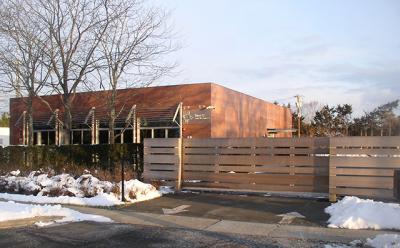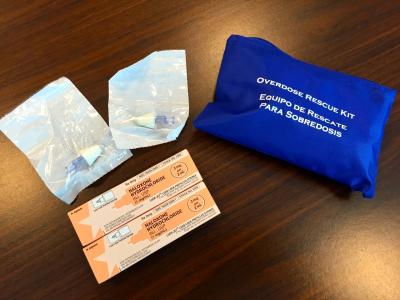Brakes on Bridgehampton Gateway
Brakes on Bridgehampton Gateway

The Southampton Town Board said Tuesday that it had heard the community’s concerns about a proposed project across Montauk Highway from the Bridgehampton Commons and decided to adjourn a hearing on it so that town planners can work to reduce its scale.
The board has been tasked with deciding whether to consider a zone change for 13.3 acres on Montauk Highway that would allow for a mixed-use complex, known as the gateway project, that would have 90,000 square feet of commercial space, including a fitness center and restaurant, and 30 residential units, mainly second-floor apartments. A dozen residents spoke out against the Gateway Planned Development District at a public hearing Tuesday night, citing environmental concerns for neighboring Kellis Pond and traffic concerns on an already busy stretch of Montauk Highway, just west of downtown Bridgehampton.
Under town code, a planned development district must have a community benefit. After three public hearings on the matter, the town board could have moved forward with the planning process, town planners said.
“I feel like electing to consider it would send the wrong message, that this plan in its current form is acceptable enough to move forward. That is not what I’m hearing from the community,” Supervisor Jay Schneiderman said to a round of applause from the audience.
Mr. Schneiderman, who took office in January long after the project was first proposed, said it is different from most other planned development districts in that it was the town, not the developer, that initiated it. The town set out to come up with a mutually agreed upon project that would give the community a place to come together and also provide affordable housing, while maintaining some of the area’s rural character. “What I’m hearing is that people feel like the town didn’t do that, we didn’t achieve that,” he said. “We need to take a closer look at this.”
The supervisor asked the developer, Greg Konner, if he would be willing to meet with the town to discuss “other possibilities that a community might be more willing to embrace.”
“We can talk,” said Mr. Konner, from the audience. He had not said anything during the hearing otherwise.
“We are thrilled that the board seems to realize the community of the East End is truly upset with the gateway proposal,” said Bonnie Verbitsky, who led a group opposed to the project called Bridgehampton Action Now. She handed in a petition with nearly 800 signatures. “Our BAN Committee is working hard to get more supporters. This is far from over.”
The proposal envelopes nine separate, but contiguous, lots that were highlighted in a Bridgehampton Hamlet Center strategy plan, adopted in 2003, as having the potential for mixed-use development. The town hired a consultant in 2004 to come up with a more detailed plan for the site. The process stalled in 2008, but came back to the forefront in 2014, in the midst of development pressures on Main Street in Bridgehampton. The town suggested the gateway property as an alternative location for a CVS pharmacy being planned at the intersection of Montauk Highway and the Bridgehampton-Sag Harbor Turnpike.
A new concept emerged for 90,000 square feet of first-floor retail space, ranging from 15,000 square feet to 3,600 square feet. The 30 residential units would include 25 one-bedroom apartments and 5 two-bedroom apartments, all designated as affordable housing, and 8 condominiums that would be sold at fair market value. The plan calls for 235 parking spaces, in spaces like those that are found on Main Street, instead of in a parking field like at the Commons. The complex would have a state-of-the-art sewage treatment plant. A 1.5-acre field in front would be left as open space.
By comparison, the Bridgehampton Commons has over 200,000 square feet of retail space with about double the parking on over 20 acres of land.
Environmentalists and residents, mainly those in the Kellis Pond Association, which abuts the property, have raised concerns about how the project will affect the health of the pond. Added noise, lights from cars, and concerns over “transient” residents were also raised. Still others were concerned the complex would exacerbate the already existing bottleneck at the light.
“We don’t need another shopping center across from the Commons,” Ms. Verbitsky told the board. “Why would we want to bring in more high-end stores that would be putting local business owners at risk? Why in a charming, quaint town would we want to create more pollution, waste, and an urban-like center?” she asked. “Please do not allow the beauty of Bridgehampton to be killed off by overdevelopment.”
“This is not a gateway plan, this is a giveaway plan,” said Jeffrey Bragman,an East Hampton attorney who represents BAN.
Peter Sughrue, a year-round resident of Bridgehampton, said the area would be akin to the Tanger Mall on Route 58 in Riverhead. “I dread the day that happens,” he said.
Only one person spoke in favor of the plan, Simon Harrison, a real estate agent from Sag Harbor, who said the town and residents should work with the developer on the concept, including “critically needed year-round housing stock,” before they get stuck with commercial space the developer can build as of right. “As such it might not be the best chance to save Kellis Pond, but the only chance,” he said.









